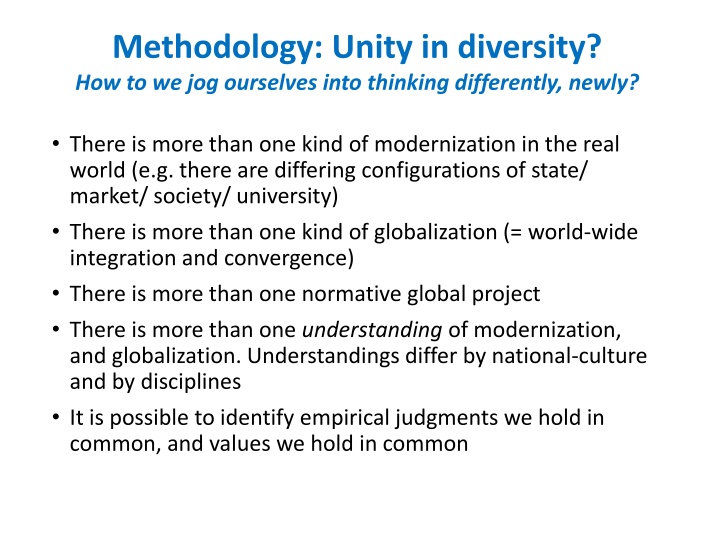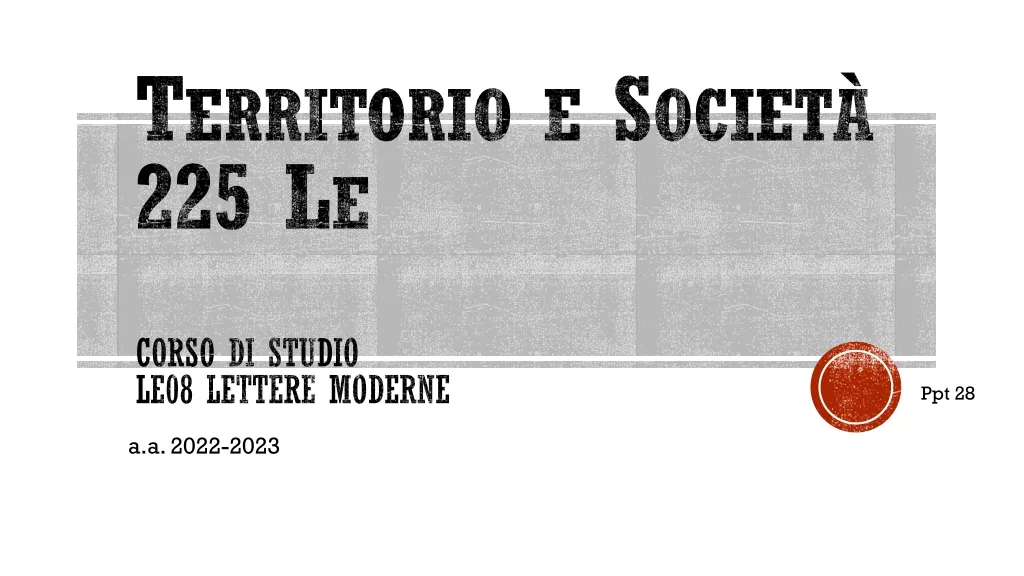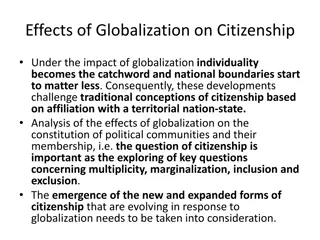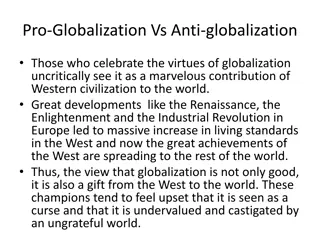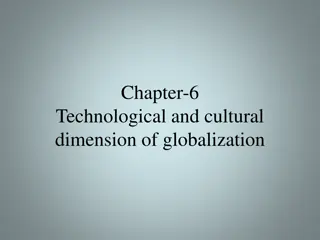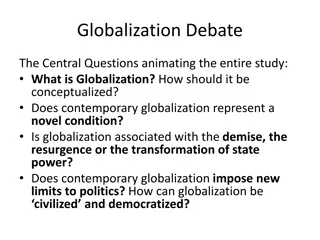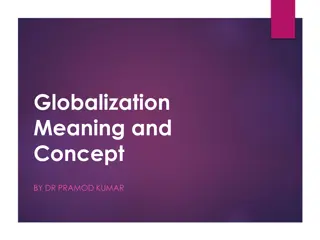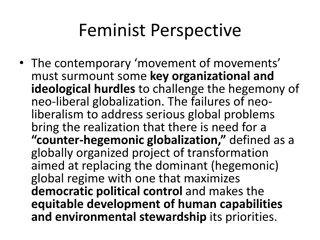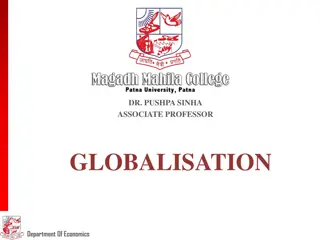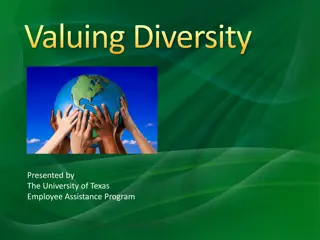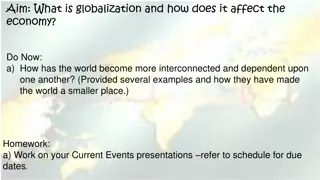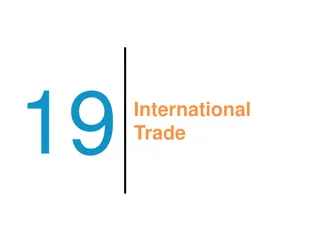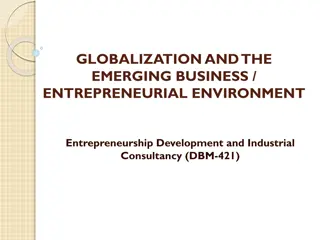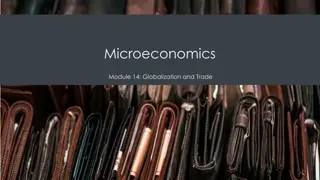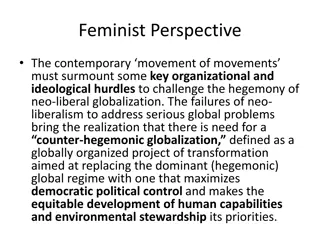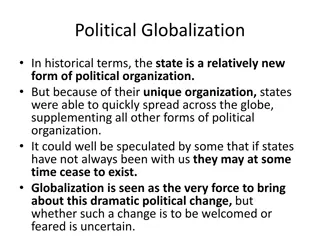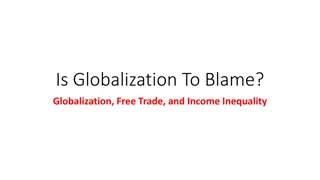Modernization and Globalization: Embracing Diversity
Embrace the diverse configurations of modernization and globalization in the real world, recognizing varying state, market, society, and university dynamics. Explore the different normative global projects and understandings shaped by national cultures and disciplines. Discover the common empirical judgments and values binding us together. Delve into the individual and collective benefits of higher education and science globally, and navigate through differing political and educational cultures across regions like the United States, Nordic countries, and Post-Confucian societies in East Asia and Singapore.
Download Presentation

Please find below an Image/Link to download the presentation.
The content on the website is provided AS IS for your information and personal use only. It may not be sold, licensed, or shared on other websites without obtaining consent from the author.If you encounter any issues during the download, it is possible that the publisher has removed the file from their server.
You are allowed to download the files provided on this website for personal or commercial use, subject to the condition that they are used lawfully. All files are the property of their respective owners.
The content on the website is provided AS IS for your information and personal use only. It may not be sold, licensed, or shared on other websites without obtaining consent from the author.
E N D
Presentation Transcript
Methodology: Unity in diversity? How to we jog ourselves into thinking differently, newly? There is more than one kind of modernization in the real world (e.g. there are differing configurations of state/ market/ society/ university) There is more than one kind of globalization (= world-wide integration and convergence) There is more than one normative global project There is more than one understanding of modernization, and globalization. Understandings differ by national-culture and by disciplines It is possible to identify empirical judgments we hold in common, and values we hold in common
Individual and collective benefits of HE and science: The same everywhere? individualised 1 Individualised national goods Individual agency freedom 2 Individualised global goods Cross-border mobility and employability Better social position Communications facility Augmented earnings and employment rates Knowledge of diverse languages and cultures Lifetime health and financial outcomes, etc Access to global science national global 4 Collective global goods Universal global science: collaborative challenges 3 Collective national goods Economic capability and evolution of occupations Diverse knowledge fields Shared social literacy, opportunity structure Zone of free critical inquiry Inputs to government Systems for exchange, collaboration, mobility Stronger regions, cities collective
Differing political and educational cultures United States Nordic Post-Confucian (East Asia and Singapore) Nation-state Limited liberal state, federal, separation from economy/market and civil institutions, constraints on state intervention. HEIs in civil society? Comprehensive Nordic welfare state, unitary, equated with society, fosters cooperative and egalitarian HEIs as part of state/society Comprehensive Sinic state, includes HE, politics commands economy. Unitary and high status state (top graduates enter state service) Educational culture Meritocratic and competitive HE market. Highly stratified, but education seen as common road to wealth/status within advancing prosperity Egalitarian, free of charge, cooperative, universal, public. Low stratification of HEIs. HE a state guaranteed medium for equal opportunity Education for filial duty and social status in stratified HE system. Confucian commitment to self-cultivation at home plus state belief in economic benefits State and family role in higher education State frames hierarchical market and steps back. Middle class family increasingly invests private resources State supervises high quality egalitarian provision. Autonomy of HEIs. Family citizen right to free education State supervises, shapes and drives the sector. Managed autonomy. Family invests much energy, time, money
What about global public and common goods? Global public goods are goods that have a significant element of non-rivalry and/or non-excludability and made broadly available across populations on a global scale. They affect more than one group of countries, are broadly available within countries, and are inter-generational; that is, they meet needs in the present generation without jeopardizing future generations. ~ Inge Kaul, I. Grunberg and Marc Stern (Eds.), Global Public Goods: International cooperation in the 21st century, New York, Oxford University Press, 1999, pp. 2 3
Common ground on global common goods? Common goods pertaining to human rights, social solidarity and equality, intercultural cooperation and international understanding, might be among the generic common goods in higher education. Also global common goods specific to higher education - - communications and mobility between universities - research knowledge in all disciplines - networked space for free inquiry and learning Who pays for global common goods and how are they regulated?
Chinese to English lexicon (Yang Lili) Term in Chinese English meaning Comments Ren is a core term in Confucianism Benevolence , Human-heartedness , or Humanity . It is an abstract term that refers to an important virtue and is often used to describe a person Tian Xia All under heaven; everything on earth (including human beings, living creatures, natural resources ) Gong Public; common; justice; for all s benefits; altruism and selfless spirit; state; social; international; openly; official; equally divided; male; Duke No explicit explanations of in Chinese, similar to public in English. Different meanings in varied situations. Tian Xia Wei Gong All under heaven is for all: people s pursuit of universal love, which includes fairness between others and oneself, people overlook specific differences in reality and seek an abstract equality No explicit connotations of public), meaning of needs further exploration
English to Chinese lexicon (Yang Lili) Term in Chinese English meaning Comments state Direct translation of state in Chinese is , could refer to both meanings as an Anglo- American term and a Chinese term, the latter more often accepted and used in Chinese is a widely-used word translated from society , so they have high degree of overlap society Though two terms represent the same meaning, individual further reflects Anglo-American individualism that the Chinese term does not naturally have. individual / public goods
From which perspective? Or a combined perspective? Observations are unavoidably position-based, but scientific reasoning need not, of course, be based on observational information from one specific position only. There is a need for what may be called trans-positional assessment drawing on but going beyond different positional observations. The constructed view from nowhere would then be based on synthesizing different views from distinct positions. The positional objectivity of the respective observations would still remain important but not in itself adequate.. ~ Amartya Sen, Rationality and Freedom, Harvard University Press, Cambridge, MA., 2002, p. 467.
How to combine different perspectives? The differing perspectives include the various national- cultural ways of seeing ; and disciplinary ways of seeing A trans-positional scrutiny would also demand some kind of coherence between different positional views ~ Amartya Sen, 2002 Sen s suggestions include - Negotiation between different national positions (which he sources in John Rawls) - The impartial spectator , sympathetic to all, but of none (which he sources in Adam Smith)
Can we identify perspectives and judgments in relation to the global setting 1. That we hold in common, 2. Where we acknowledge (and possibly value) diversity of views?
